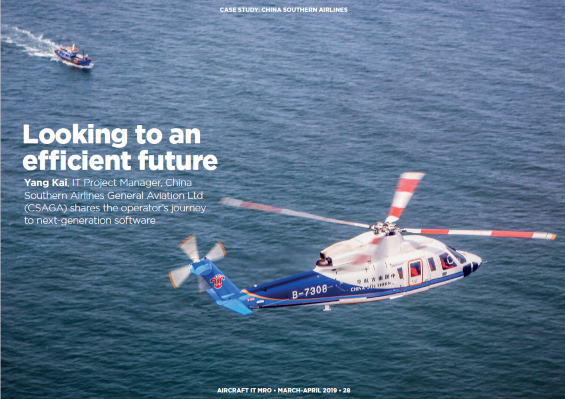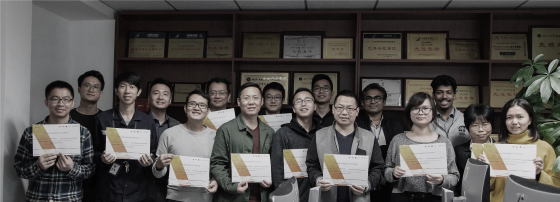Articles
| Name | Author | |
|---|---|---|
| Commercial aviation in 2019 | Mark Martin, Director Aerospace & Defence Business Unit, IFS | View article |
| MRO 4.0: The Next Big Step for Processes – Using Digital Twins and Location | Dr. Hugh Revie, Sales Director Aerospace, Ubisense | View article |
| Case Study: CSAGA Looking to an efficient future | Yang Kai, IT Project Manager, China Southern Airlines General Aviation Ltd (CSAGA) | View article |
| Effective and efficient – obtaining regulator acceptance for electronic signature | Mark Schulz, Senior Vice President Worldwide Sales, EmpowerMX | View article |
Case Study: CSAGA Looking to an efficient future
Author: Yang Kai, IT Project Manager, China Southern Airlines General Aviation Ltd (CSAGA)
Subscribe
Looking to an efficient future

Yang Kai, IT Project Manager, China Southern Airlines General Aviation Ltd (CSAGA) shares the operator’s journey to next-generation software
In this article, I want to share with readers something about the implementation of next generation MRO software at China Southern Airlines General Aviation Ltd (CSAGA). Starting with the business pain points and the key business needs that we identified as motivation to make the change, we’ll go on to look at the process by which CSAGA selected the right software provider for our needs and how the chosen provider met our requirements. The project schedule and milestones will be covered and some of the challenges that were faced during implementation as well as the implementation process itself. Finally, we’ll look at the business benefits that have been gained as a result of the implementation and the future plans for leveraging full value from the new system. Bur first, to set the scene, here’s a brief outline of CSAGA.
CHINA SOUTHERN AIRLINES GENERAL AVIATION LIMITED (CSAGA)
Founded in 1980, China Southern Airlines General Aviation Limited is the general aviation subsidiary of China Southern Airlines and is China’s second largest operator in the offshore oil & gas industry. Currently, CSAGA operates 24 aircraft, including Sikorsky (the largest operator of Sikorsky civil helicopter in Asia) and Bell helicopters, and holds certification for CAAC-145 maintenance, CAAC-91&135 operator and CAAC-147 training qualification. Offshore oil & gas services are flight services for domestic and foreign petroleum companies in offshore oil & gas exploitation, including platform crew change, personnel, material & equipment, emergency transfer, medical evacuation and typhoon evacuation. As well as offshore oil & gas, CSAGA also conducts maritime rescue operations and helicopter charters in various lines of business such as air travel, geophysical exploration, forest protection, aerial photography, power line inspection, tower hanging and hoisting, medical evacuation, and vessel pilotage. Plus, of course, CSAGA undertakes helicopter maintenance services, the subject of this case study.
The company operates from thirteen bases across China (figure 1) including 3 that are owned by CSAGA in Zhuhai, Zhanjiang and Sanya. Offshore operations cover the Bohai Sea, the Yellow Sea, the East China Sea, the South China Sea and Beibu Gulf as well as Yinggehai.

Figure 1
WHY CSAGA NEEDED A NEW MRO SYSTEM
As with any business, CSAGA had grown and had updated its systems as required but, again as with any business, this eventually put some strain onto the overall system and was beginning to be a drag on our activities. Everything worked but we realized that it could work even better. A number of pain points were identified along with a number of business needs to support future progress.
Business Pain Points
Over time, we had identified, in the CSAGA MRO operation, a number of business pain points that needed to be addressed in order to ensure that the operation was fully up-to-date and future ready. These can be summarized as below:
- The business was using multiple and disparate systems which were giving rise to data inconsistencies and the need for repeated data entries. Both of these were adding non-productive time to our activities and, therefore unnecessary costs.
- Our maintenance planning and execution was a manual process undertaken by the hangar department and so subject to the time requirements and inconsistencies associated with any manual operation.
- Similarly, task compliance monitoring was a manual process in the Quality and Engineering department.
- There was a lack of real-time stock visibility leading to overstocking in some cases and/or parts being unavailable when needed in other cases.
Key Business Needs
Looking beyond where we were, CSAGA identified a number of key business needs that we felt would help the business to work more effectively and efficiently and be able to not only continue to offer an excellent service but also to adapt to whatever changes and challenges the future might hold. Summarized as below are some of the key outcomes that we wanted from the new system:
- One integrated system with streamlined processes and cross-department interactions so that we no longer had to move between systems and to eliminate data inconsistences and the need for multiple entries of data.
- An advanced maintenance forecasting and planning process within the system to eliminate the need for a manual planning process.
- A reduction in maintenance turnaround times (TAT) to increase aircraft availability.
- Improved stock visibility through all stages of Maintenance and Supply Chain management.
THE SOFTWARE SELECTION PROCESS
Having carefully identified the pain points for and business needs of CSAGA, the next step was to select a software provider from among the many in the market: a provider whose solutions would best support the elimination of those pain points and the fulfilment of those key business needs. CSAGA designed a rigorous selection process which included a number of steps and assessment criteria.
- In the first instance, we compiled our requirements based on the identified pain points and business in an assessment of the shortcomings in the existing process.
- We next undertook a survey of the market to see what providers there were who might be able to address our requirements.
- Bearing in mind the market space we occupy, we also got feedback from other helicopter operators who would have faced similar challenges to those we were seeking to resolve.
- Armed with all of the above inputs, we drafted the specifications of what we were looking for from a new MRO solution and…
- … with that specification, we floated an RFP (Request for Proposal) into the market to see which providers responded.
- Each response was first subjected to an evaluation of the technical specifications and, for those proposals whose technical specifications were accepted…
- … they were subjected to an evaluation of the commercial aspects of the offer.
This process produced a shortlist of three vendors who were further assessed based on their software demonstrations on premises, according to three weighted evaluation criteria:
- A 50% weighting was given to an evaluation of the extent to which the offer covered the requirements in the RFP:
- A 30% weighting was given to a product demo, organized for each of the shortlisted 3 providers;
- A 20% weighting was given to the extent to which the proposal matched CSAGA’s IT compliance requirements.
THE SELECTED SOLUTION
At the end of the selection process, the provider who best matched CSAGA’s requirements was Ramco Aviation Systems, whose scope met our needs. We also visited one of their customers who had been live on Ramco for over a decade to get a better understanding the benefits and implementation process.
SOLUTION SCOPE
The selected system offered CSAGA a comprehensive and end-to-end integrated software for configuration management, component maintenance programs, technical records management, reliability and quality/safety audit. It included the capability to develop and manage aircraft maintenance programs along with the management of Service Bulletins and Airworthiness Directives SB/AD; offering aircraft maintenance planning, component maintenance planning, tools and equipment management, and work center management. The solution covers a range of logistics issues including parts administration, warehouse management, stock management, general procurement, component repair and exchanges. This includes line maintenance and heavy aircraft maintenance as well as in-house component repairs. The scope also includes the maintenance of employee profiles and the management of training programs and qualifications records. With all that settled, the remaining and large task was to implement the new solution.
PROJECT SCHEDULE AND MILESTONES
Considering the breadth of the scope and the work required to implement this new system, the whole process was completed in the very creditable time of nine months from the initial project kick-off in May 2017. Also in May 2017, the Project Charter was finalized and agreed and Conference Room Pilot (CRP) discussions took place. By July 2017, solution confirmation and closure had been completed ready for preparatory work to be undertaken prior to the first data migration mock to test the new system in October 2017. November 2017 saw the training of User Champions to help colleagues with the implementation and bedding in of the system; also, there was the second mock data migration. User acceptance training took place in December 2017 as did the third and final mock data migration, incorporating all that had been learned in the first two mock migrations. January 2018 was a busy month with end user training and the cut-over data uploads for the fleet prior to a Go Live sign off in February 2018.
CHALLENGES IN IMPLEMENTATION
As in every implementation, there were challenges related to the system and with the people who would be using it; some were foreseen, some were less expected and at least one was wholly out of the control of either CSAGA or Ramco. This included some reorganization in affected departments with reassignment of responsibilities in order to align the structure of the business with the way that the new software worked.
Personnel-based challenges were more diverse. Discussions had to be conducted in multiple languages, English and Chinese, requiring us to put both Chinese and English speaking staff and consultants on-site. Also, with employees spread across CSAGA’s thirteen bases, training presented some challenges which were overcome by posting User Champions in different bases to train end users. In any move from multiple systems and legacy data management to a single system, there will be data collection and validation challenges and this implementation was no exception with the need to collect data from multiple available sources and undertake consistency checks on the variously sourced data. The transition to the Ramco system required the shutting down of the old systems and processes in order to implement and follow the new system and its processes.
Some things cannot be planned or legislated for and that was the case when Typhoon Hato struck in 2017, causing the whole project to have to be put on hold for two months.
IMPLEMENTATION PROCESS
Notwithstanding all of the challenges, the process went well and was divided into three stages.
Solution definition
A thorough site study was conducted by Ramco to understand the department structure, roles and responsibilities, and processes in CSAGA and which would need to be followed by Ramco who introduced industry best practices and processes based on experience with other helicopter operators.
Data migration
Data from different sources such as manual reports and legacy systems were collected, validated for consistencies and then migrated to Ramco. A total of three mocks of data migration were conducted to cleanse and improve data quality. Each of the mock uploads resulted in increased accuracy of the data and reduced time for uploading.
Training and testing
Different user champions from each department were nominated for process training. These user champions were trained on Ramco, according to their responsibilities, and they, in turn, trained the end users in their departments. Post training, a round of user acceptance testing was conducted and clearance was provided for Go Live.

BUSINESS BENEFITS REALIZATION
Following the implementation and with the benefit of experience using the new system from Ramco, CSAGA has identified the business benefits that had been realized at the time of writing and the list is already impressive.
Technical Records
- Structured multi-level configuration and maintenance programs with strong component replacements and task compliance tracking.
- Effective monitoring of aircraft and component utilization and ageing.
- Elaborate flight parameter reporting helps identify abnormal flight performance and troubleshooting.
AD/SB Management
- There is now a comprehensive process for AD/SB applicability assessment and EO (Engineering Order) execution.
- Enhanced compliance monitoring and reporting of ADs (Airworthiness Directives) and ASBs (Advisory Service Bulletins).
Centralized maintenance planning
- Advanced forecasting and visibility of due tasks for aircraft stationed across the thirteen bases.
- Work Order packaging of due tasks with automatic allocation of parts in stock.
- Repair planning, based on demand, for components available in ‘unserviceable’ warehouses.
Inventory management
- Maintains an optimum inventory based on stock analysis, plus reduces excess procurement and transfer between stations.
- Lean ‘Goods Receipt’ process with inspection, certificate attachments and parts binning.
- eQuote – Automated RFQ (Request for Quote) emails to suppliers and quote generation based on supplier response.
Maintenance execution
- Maintenance execution with access to a real time stock profile which improves efficiency and reduces TAT.
- Effective discrepancy deferral process supported by component replacements integration with configuration.
- In-built regulatory compliance certificate AAC-038 form.
Employee training
- Detailed employee profile maintenance with proactive monitoring of employee skills and licenses.
- Structured training plan to meet skill requirement demands with growing business and fleet induction.
FUTURE ROAD MAP
With the new system installed and working, CSAGA is already looking to the future and some ideas on how to leverage Ramco’s power and capabilities to further improve the business. We are planning for tool crib automation using new technologies and also leveraging advanced optimization tools for reducing inventory costs.
SUMMARY
This has been our journey at China Southern Airlines General Aviation to upgrade our MRO system from multiple legacy solutions to a single next generation solution with all of the efficiencies that entails. I hope that you also will find our experience useful when you are also contemplating such a move.
Contributor’s Details

Kai Yang
Kai Yang is currently a Senior Engineer with China Southern Airlines. He is also an S92 Mechanical Instructor in the training department of China Southern General Aviation Company.
China Southern Airlines General Aviation

China Southern Airlines General Aviation Ltd (CSAGA), a general aviation subsidiary of China Southern Airlines, is the China’s second largest flight operator in offshore oil & gas industry. Currently, CSAGA operates 24 aircrafts including Sikorsky and Bell helicopters and holds the certification of CAAC-145 maintenance, CAAC-91&135 operator and CAAC-147 training qualification.
Ramco Aviation Software
Ramco Aviation Software for Aerospace & Defense is an M&E / MRO software addressing the needs of the airline, helicopter operator, MRO, and business aviation segments. Leveraging the suite’s vast array of applications, one can automate operations, end-to-end, reduce overhead costs, manage inventory more effectively, increase aircraft availability, reduce AOG (aircraft on ground) times, and control operations on a business-for-profit basis.

Comments (0)
There are currently no comments about this article.

To post a comment, please login or subscribe.